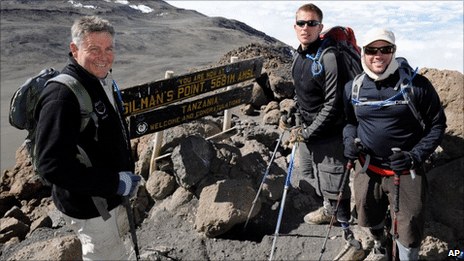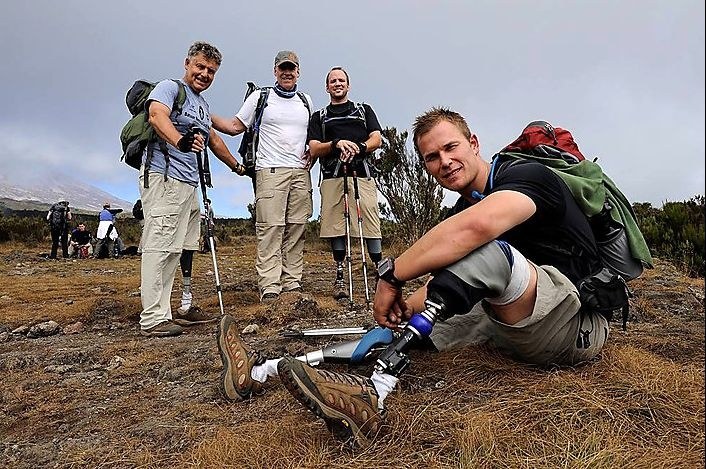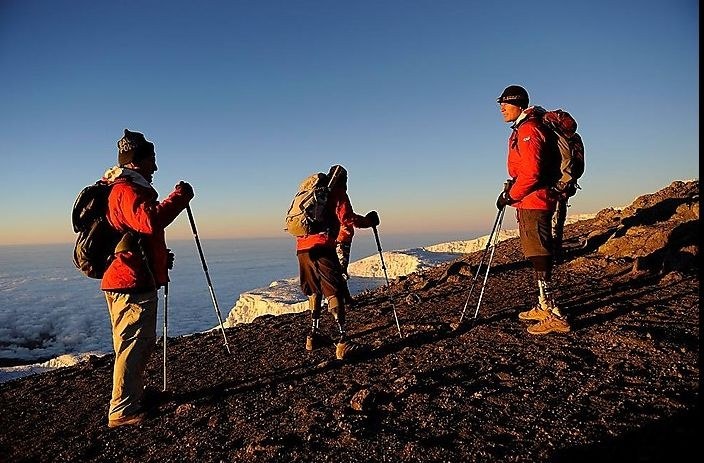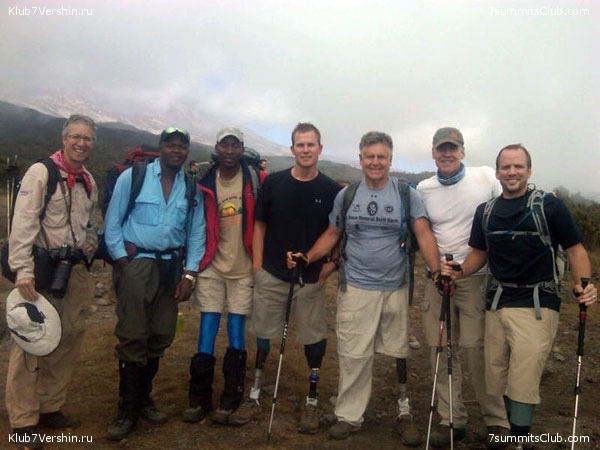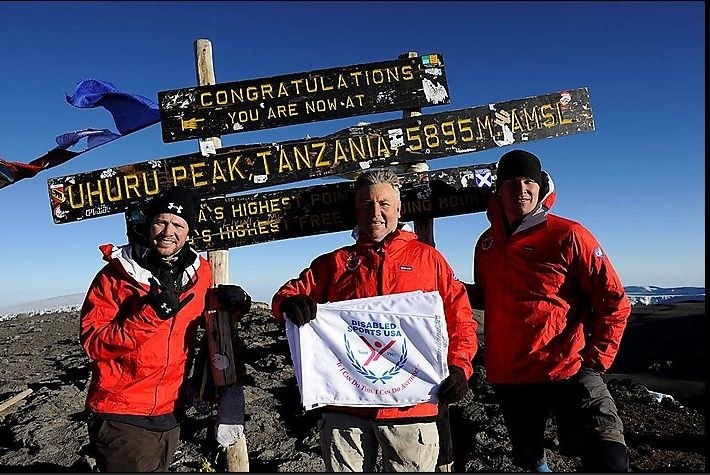All news: 27 August 2010
With one good leg for three, US veterans climb Mount Kilimanjaro
Kilimanjaro.
Don't ever make the mistake of telling Kirk Bauer he cannot do something. The Ellicott City resident was one of three amputee retired veterans -- with only one good leg among them -- who earlier this month climbed Mount Kilimanjaro, ...
Don't ever make the mistake of telling Kirk Bauer he cannot do something. The Ellicott City resident was one of three amputee retired veterans -- with only one good leg among them -- who earlier this month climbed Mount Kilimanjaro, Africa's highest peak, in a living-billboard effort to show people with disabilities that there are no limits on what they can do.
"It was an experience of a lifetime," said Bauer, 62, the one with the good leg. "It was everything we expected and more -- and it was just amazing."
The climb up the 19,340-foot Mount Kilimanjaro began Aug. 2 guided by Nickson Moshi, owner of Massai Giraffe Safari, who has experience helping disabled climbers.
On Aug. 7, they reached the top.
"We were pretty choked up. It was a pretty emotional experience," Bauer said. "There was a lot of hugging going on."
Bauer lost a leg from a hand grenade during an ambush in 1969 while serving in the Ninth Combat Infantry Division in Vietnam, where he earned two Bronze Stars for heroism.
Joining him on the quest for Kilimanjaro was Sgt. Neil Duncan, 27, from Maple Grove, Minn., who lost both of his legs after being severely injured in Afghanistan in December 2005 by an improvised explosive device; and Staff Sgt. Dan Nevins, 39, from Jacksonville, Fla., who lost his left leg below the knee in November 2004 while serving in Iraq. In 2007, he suffered life-threatening infections in his remaining leg and had to have it amputated.
Bauer is executive director of Disabled Sports USA, a Rockville-based nonprofit sporting organization for people with physical disabilities. It has more than 60 chapters worldwide and serves more than 60,000 people, according to the organization. Bauer volunteered with the organization for 12 years and has been the executive director for the past 28 years.
Bauer, Nevins and Duncan formed Team Missing Parts In Action as part of Disabled Sports USA's Warfighter Sports Series, a schedule of challenge events that help military service members with permanent disabilities train for and challenge themselves in extreme and endurance sports.
While all three successfully reached the summit, Nevins became ill on the descent, with fever, congestion and an infection in his stump and was evacuated on a wheeled stretcher and hospitalized, Bauer said.
It was Duncan who set the trip in motion, unknowingly, a year ago. He tried to climb Mount Kilimanjaro with a guide but was unsuccessful. At a banquet for disabled skiers in Colorado last year, Duncan said he wanted to try again.
"He stood up and challenged me, in front of nearly 500 people, to join him," Bauer said.
"No" was not an option.
On the trip, Bauer kept a daily blog.
At the completion of the challenge, he wrote:
"We hiked through a beautiful rain forest that was filled with exotic plants, hanging moss, Blue Monkeys and beautiful flowers. We finally reached the Marangu Gate, the official end of our climb. Totally sore from head to foot, exhausted from 8 days of heat, cold, wind, muscle strain, and mechanical problems, we arrived late in the afternoon today.
I cannot even begin to convey the exhilaration of finally reaching that cold windy summit of Mt. Kilimanjaro and then finally descending to Marangu Gate, to make our climb official.
Certainly we all feel a great deal of personal satisfaction in setting and achieving a goal none of us was sure we could accomplish. But we all hope that this accomplishment will have more of an effect than personal satisfaction."
New challenges every day
Each day presented challenges of its own.
The men were constantly slipping on loose gravel on the pathways, Bauer said.
They had to deal with extreme fluctuations in climate and temperature.
And then there was the struggle of coming down.
"For an amputee, coming down is almost as hard as coming up," Bauer said. "By the time we got back down to 15,000 feet, we were exhausted. There were times when I said to myself, 'Are you going to make it?' You mentally keep saying to yourself put one foot in front of the other, over and over again."
There was also the issue of Bauer's "spare" leg.
As a precaution, Bauer brought along an extra leg and a pair of crutches.
At 15,500 feet, the men awoke early to head for the summit, stay overnight and come down. To save weight, Bauer opted to leave his extra leg at their camping spot.
Then his computerized prosthetic leg, which automatically adjusts for different terrains, "froze up," Bauer said.
"The leg froze up and becomes like a peg leg," he said. "I did it like a peg leg Pete."
The next day, when he put the spare leg on, the socket was too big and the leg kept falling off, Bauer said.
Meanwhile, Duncan had his own struggles.
"Neal fell flat on his face several times, and flat on his back," Bauer said. "He kept getting up and just kept going."
Bauer said his companions inspired him every step of the way.
"They were just phenomenal," he said. "We all knew what our objective was. It was very simple: Climb the mountain. We did not have one incident where anyone wanted to give up."
Bauer attributes the success of the climb to the training all three men did for months before their departure.
"Every single ounce of training paid off," said Bauer, who took only one day off when he returned to Maryland before going back to work.
Part of Bauer's training included participating earlier this year in the annual Battaan Memorial Death March, a 26-mile course in New Mexico dessert terrain with a backpack.
"The Battaan March got us off on a good jump start," said Bauer, who also climbed three 14,000-foot mountains in Colorado over the past year.
He also gave credit to their team of guides, led by Nickson Moshi
At one point, Nixon offered to carry Bauer.
"I said, 'This is something I have to do myself,' but they were willing to carry me," he said.
In September, Bauer will participate in the 3 Notch Century, a 100-mile bike ride through three mountain ranges in New Hampshire.
"We achieved our goal, but the bigger message is if three guys from three different wars, with one good leg between them can do this, certainly our friends with disabilities can get out and bike a mile, hike a mile," Bauer said. "I hope people will get the message that with your disability, you can still be active. You are going to live a more healthy, richer life for it."
Bauer knows from painful experience.
In 1969, after six months in the hospital and seven surgeries, he was depressed, without hope and thinking about suicide. Then on the last day of that year, he took his first skiing lesson.
"To go from that to screaming down the mountain on one leg, the freedom, the speed, the fresh air -- it was a head-turner for me. It changed my whole perspective on life," he said. "This is what sports does for us all. I became a skiing addict after that."
He also became a teacher, someone to show wounded warriors what can be done.
"These soldiers who are wounded, they only respect action. They don't respect people spouting off about health and fitness. They respect people who are doing it," Bauer said. "I tell them, 'I have been where you are.'"
These days, the level of training, the quality of adaptive equipment and the number of training programs all play a role in increasing the physical activity of disabled veterans.
"We had none of that back in 1969 when I got hurt," Bauer said. "We were literally putting together equipment with duct tape to make something work so the person could get out and do something with their disability."
Back then, skiing was the one sport offered to amputees. Now there are 20, Bauer said, for every injury ranging from traumatic brain injuries, to spinal chord injuries to blindness.
"Unfortunately there are several surviving quadruple amputees of this war, and we have them golfing, scuba diving, cycling and skiing. That is how far we have come," Bauer said.
To this day, he wears shorts, even in the middle of winter.
"I want to let people know, there is life after disability," Bauer said. "It really does make you feel like you can get out there and conquer life."
Explore Howard County
